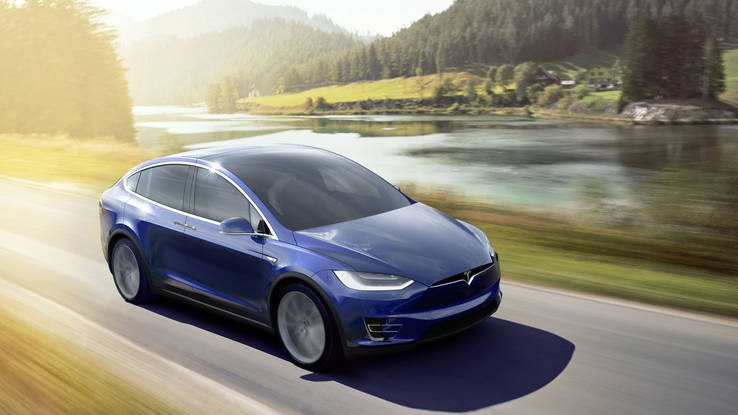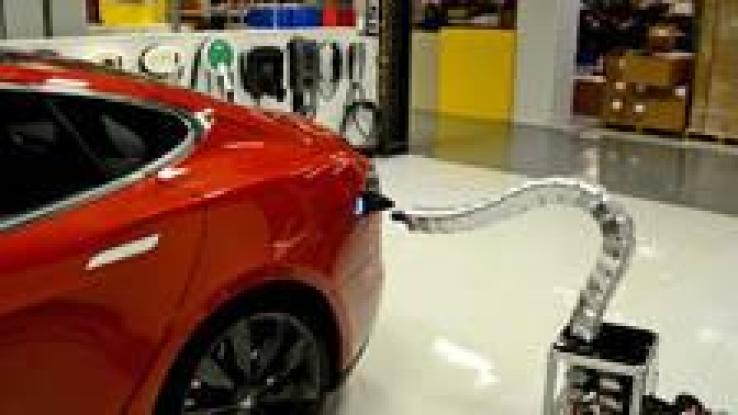Tesla shows its revolutionary electric SUV
Three years, seven months and 20 days.
That’s how long has passed since Tesla Motors CEO Elon Musk first unveiled a prototype of the Model X at its design studio near Los Angeles, billing the all-electric crossover as a vehicle with “more functionality than a minivan, more style than a SUV and more performance than a sports car.” At the time, Tesla opened an order list for buyers willing to put down deposits of $ 5,000 to $ 40,000 to stand at the front of the line when deliveries began.
That moment of truth has finally arrived.
On Tuesday evening, Tesla held a ceremony near its assembly plant in Fremont, Calif., to mark the start of sales by delivering the Model X to six of its earliest hand-raisers, and unveiling the eye-popping technology that delayed the launch so far beyond Tesla’s original sales target of 2013.
“In retrospect,” Musk told reporters Tuesday, “I think we got a little carried away.”
The basic design of the Model X has hardly changed since Musk unveiled the prototype in early 2012, but Tesla kept some surprises up its sleeve.
On Tuesday afternoon, Tesla gave us a chance to drive the Model X and fiddle with its avant-garde features, from the “falcon wing” doors to the motorized second-row seats.
Here are our answers to some burning questions about the Model X.
Has Tesla matched Mercedes-Benz on interior luxury?
Though the Model S dazzled customers in many ways, buyers griped about uncomfortable seats, cheap-looking plastics and flimsy sun visors that seemed out of place in a $ 100,000 luxury car. Tesla chalked it up to growing pains. Elite suppliers rebuffed Tesla during Model S development, wary of taking on an untested automaker as a customer.
“With something like the visor, we ended up having to go to a third-rate supplier and then work on fixing the situation after the car had already started shipping,” Tesla design chief Franz von Holzhausen said, according to Ashlee Vance’s book, “Elon Musk: Tesla, SpaceX, and the Quest for a Fantastic Future,” published in early 2015.
Fast forward five years, and suppliers are now clamoring for Tesla’s business. But has Tesla caught up to its European luxury rivals with a sumptuous cabin for the Model X?
When it comes to technology and comfort, the cabin of the Model S is on point. The front seats — one of the biggest gripes about the Model S — are supremely comfortable. Designed from scratch, they now offer both heat and ventilation.
Perhaps the biggest surprise, though, is the booming 17-speaker, 560-watt audio system — an unbranded setup that Tesla designed itself with an in-house team of audio engineers. It doesn’t have a prestigious brand like Burmester, Bowers & Wilkins or Bang & Olufsen, but it pumps out tremendous amounts of bass without overwhelming the music.
When it comes to design, though, the Model X isn’t quite on par with the best of the luxury world. Yes, the leather is fine. Yes, the black-and-white color scheme is striking. Still, it lacks the attention to detail of a top-of-the-line Audi or Mercedes-Benz. Particularly lacking is the center console, with poor ergonomics and cubbies that look thrown together.
Do the “falcon wing” doors work?
Car designers have toyed with upward-opening gullwing doors for more than 60 years, from the iconic Mercedes-Benz 300SL (1954-63) to the ill-fated DeLorean DMC-12 (1981-83) and more recently, the $ 1.3 million Pagani Huayra supercar (2012-present).
Yet gullwing doors have been fraught with problems. Poorly designed, they are prone to leaks. They can slam into low ceilings. They can even trap occupants if a car flips over.
Tesla seeks to overcome the shortcomings with the “falcon wing” doors on the Model X. If they work, Tesla will have an eye-catching feature to set itself apart. If they don’t, Tesla will have a headache, as with the failure-prone retracting door handles on the Model S.
So, are they a stunt or a success?
To me, they’re highly functional and sure to draw crowds, but they don’t quite feel natural.
Park near another car in a parking lot, and the doors will gauge the distance, folding and rising to open as wide as possible. The driver can open and close the hatches from the giant 17-inch touchscreen in the dashboard. It’s all very impressive.
However, opening the doors is a bit of an ordeal. The falcon-wing doors are slower than regular doors, and they beep a lot. If you’re inside the car, they make unsettling whirring sounds, lacking the visceral thunk of slamming shut a traditional door. None of these are fatal flaws, to be sure, but it may take time for owners to feel comfortable with them.
Tesla’s biggest challenge with the doors was sealing them so they wouldn’t leak. That will be the true test, and one that I could not have tested without sneaking out to a car wash.

Model X is mostly as good as they say.
Are the backseats as functional as promised?
To understand the design of the Model X, it helps to understand that Musk has five sons: a pair of twins born in 2004 and a set of triplets born in 2006. Sensitive to the needs of large families, he conceived the Model X with decent leg room in the third row and sliding second-row seats that allow for easy entry.
It turned out that the second-row seats were a bigger engineering challenge than the falcon-wing doors, Musk told analysts during an August earnings call. “It’s an amazing seat, a sculptural work of art,” Musk said, “but a very tricky thing to get right.”
Did Tesla get it right?
They certainly look fantastic. The second-row seats are slim and curvaceous, and they stand on shiny individual “monoposts” to move independently from one another. Each seatbelt is integrated into the seat, which helps with access to the third row and gives the second-row seats a futuristic look.
They are also comfortable and spacious. It’s easy to enter and exit the third row by pressing a button near the shoulders of the second-row seats. The third row has ample room for tall adults if the second row is moved forward. The seats, mounted on tracks in the floor, move with a grinding whirr, somewhat like an electric can opener.
Does the Model X actually drive like a sports car?
To reduce cost and engineering challenges, Tesla designed the Model X to share most of its powertrain with the Model S sedan, including the dual-motor awd configuration and a choice of 70 kWh, 85 kWh and 90 kWh battery packs.
The high-riding Model X is a little bit less efficient than the Model S, with an EPA range rating of 257 miles for the 90D model, compared to 270 miles for the equivalent version of the Model S. But does the SUV stance also lead to compromised performance?
No, it doesn’t.
Despite its size, the Model X moved nimbly through a snaking course of cones in a parking lot, aided by a low center of gravity from stashing batteries beneath the floorboards.
Launches in the top-of-the-line P90D were mind-blowingly fast. Tesla quotes a time of 3.2 seconds from 0-60 for the top-of-the-line P90D with “ludicrous mode,” 3.8 seconds for the P90D and 4.8 seconds for the 90D.
The sensation of my head slapping against the headrest gives me no reason to doubt that those numbers are accurate.

What’s up with that giant windshield?
In early September, with the first deliveries of the Model X weeks away, Tesla asked a handful of customers who put down deposits to customize their car online. Renderings shared with these customers showed a panoramic windshield stretching above the driver’s head, seemingly in lieu of a traditional sunroof.
Tesla wouldn’t be the first to offer such a feature. General Motors offered a similar panoramic sunroof in the previous-generation Opel/Vauxhall Astra hatchback that went on sale in 2004. So, how does it work?
Well, they look great from the inside, offering a wide open view of the sky. From the outside they look snazzy, designed with a gradient that flows from clear in the front to tinted overhead, blending in nicely with the blacked-out roof.
In one of the cleverest bits of engineering in the entire Model X, the sun visors rest along the A-pillars, above the windows. They fold for a sleek profile when docked, clicking into place with magnets. Extend the sun visor over the windshield, and those same magnets lock the visor to the rear-view mirror, which is mounted smack in the middle of the glass.
It is “definitely the most complex sun visor in history,” Musk told reporters Tuesday.
It was an awkward problem, but Tesla found a solution. And that’s the story of the Model X. Musk strived so hard to make the Model X different that it took years to bring his brainchild to market. If you ask him, he will concede: maybe it didn’t need to be so different.
“In retrospect, we would not have done so much in the way of features and functionality for the X,” Musk said. “People are going to get an incredible car that does so many things that no other car does, but it didn’t need to do quite as many things.”
“Now that it’s done,” he added, “I think anyone who buys it is going to love it.”






























